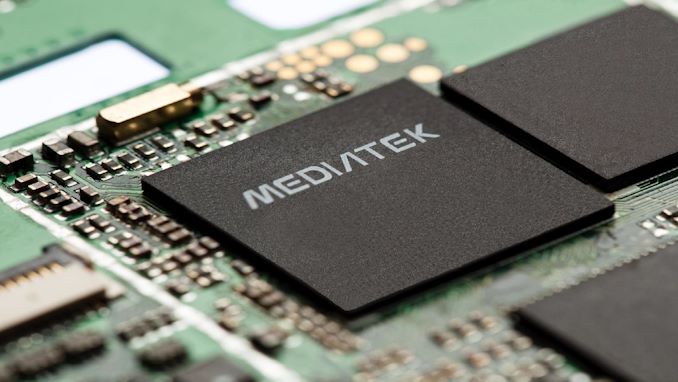MediaTek Announces T700 5G Modem Powering Intel PCs Successfully Certified
by Andrei Frumusanu on August 6, 2020 7:00 AM EST
Last year, Intel and MediaTek had announced a partnership with the goal of developing a 5G modem that would be used in future next-generation PC platforms. The move followed Intel's sale of their own cellular modem divison to Apple for $1B.
Today, MediaTek and Intel are announcing the name of the modem, the MediaTek T700 modem, and that the product has passed important milestones in development, having finished the hardware design phase and having been sucessfully certified and tested in real-world 5G SA (Standalone) network calls.
It's also been announced that Intel is advancing with platform system integration on their part, and readying co-engineering resources and support for OEM partners in order to develop end-products with the Intel and MediaTek platforms.
“Our partnership with Intel is a natural extension of our growing 5G mobile business, and is an incredible market opportunity for MediaTek to move into the PC market,” said MediaTek President Joe Chen. “With Intel’s deep expertise in the PC space and our groundbreaking 5G modem technology, we will redefine the laptop experience and bring consumers the best 5G experiences.”
“A successful partnership is measured by execution, and we’re excited to see the rapid progress we are making with MediaTek on our 5G modem solution with customer sampling starting later this quarter. Building on our 4G/LTE leadership in PCs, 5G is poised to further transform the way we connect, compute and communicate. Intel is committed to enhancing those capabilities on the world’s best PCs,” said Chris Walker, Intel corporate vice president and general manager of Mobile Client Platforms.
The MediaTek's T700 modem supports sub-6GHz NSA and SA networks, with future generations planned with mmWave connectivity.
The two companies re-iterate their goal of shipping the first laptops with the 5G modem solutions in early 2021.
Related Reading:
Source: MediaTek Press Release










15 Comments
View All Comments
fazalmajid - Thursday, August 6, 2020 - link
Another nail in the coffin of 30GHz mmWave 5G, which literally can't punch its way out of a paper bag?deil - Thursday, August 6, 2020 - link
placing might be a challange but once you are in, nothing will stop you from getting full bandwith.on 2.4g long range is a curse in flats. my phone can detect ~30 wifi networks on 2.4g and like 13 on 5g. mm 'ish wave would be good, IF it works though wood, but not concrete.
hanselltc - Friday, August 7, 2020 - link
I believe if it "literally can't punch its way out of a paper bag" it won't work through wood kekdotjaz - Saturday, August 8, 2020 - link
Why do you think laws of physics is an "IF"? Both 2.4GHz/5.8GHz signals are capable of penetrating walls, mmWave literally can't.Santoval - Thursday, August 6, 2020 - link
It never could. You can't beat the laws of physics. What you *can* do is install femto/nano/microcells everywhere in a city (and only in a city), and by everywhere I mean *everywhere*, but which company is going to do that? One idea is they might give the cells, either static or mobile, to the 5G users. One femto/picocell for each 5G subscriber. That could work. Barely. If they manage to sell the cells and their cost is low enough.By contrast, sub-6GHz 5G is just souped up LTE 4G. A few more CAT iterations paired with the required large enough QAM modulations and its speed would have been reached by LTE - or would have come very close. sub-6GHz is basically LTE 4G+ (if that doesn't already exist) but it's the actual usable "5G". mmWave 5G, the actual, super fast but super weak 5G, was designed for marketing purposes to push sub-6GHz along with it and the telcos hoped most people would confuse the two or think they are comparable. Noobs and tech illiterates certainly do.
close - Thursday, August 6, 2020 - link
That's great if I'm at home and the *cell is connected to a cable and provides the full bandwidth of that connection to my phone and with LoS to it. But then again in that situation I'm better off using WiFi. I want fast mobile connection when I am on the move. And on the move you will rarely have that needed LoS unless someone installs cells *everywhere*. Manhole covers, drainpipes, utility poles, etc.I agree with the rest, much of what 5G is today was designed to look good on a marketing flyer. This counteracts the slowdown in phone improvement as people start throwing money on new phones and better data plans.
Spunjji - Thursday, August 6, 2020 - link
Ugh, that statement from Joe Chen."groundbreaking 5G modem technology" - not really, it's been done several times already..?
"we will...bring consumers the best 5G experiences"
Doesn't that require a centrifuge?
yeeeeman - Thursday, August 6, 2020 - link
Happy for them since I am a bit tired of Qualcomm getting the entire cake.JayNor - Thursday, August 6, 2020 - link
Is Huawei's 5G modem not functional?JayNor - Thursday, August 6, 2020 - link
I didn't see mention of multi-mode LTE 4g/5G. Seems like with 5G's wall penetration problems 5G alone would be a limited solution ... maybe efficient for industrial applications, but not so good as a laptop always connected solution.btw, I believe Intel only gave up rights to the smartphone 5G modem use case. Their statements indicate they reserved rights for other cases, which I guess could include always connected laptops and the mobile 5G vehicle to vehicle applications. Hard to see how they do that without a design group, so maybe MediaTek will work with them on other projects. Intel also needs a Foveros 3D compatible 5G chiplet.